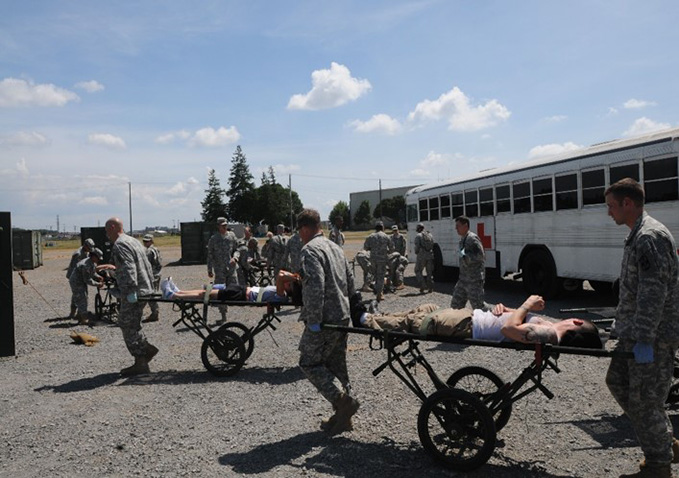Ready People to Hand off Ready 'Stuff'

Can you imagine moving a whole hospital from one continent to the next with little or no notice?
In the military, troops have to be ready for rapid deployments – and supporting medical teams have to be just as fast and agile.
Instead of always shipping large quantities of equipment and supplies to distant locations, units may leverage Army Prepositioned Stocks. The APS program strategically stores equipment and supplies on land and at sea all around the world. APS allows units to mobilize quickly and efficiently, knowing the equipment and supplies they need will meet them in a deployed setting.
The current APS program began in 1992 when the Chief of Staff of the Army directed a reduction in War Reserve and operational project stocks, and transferred management and accountability responsibilities to the U.S. Army Materiel Command – all except for medical materiel (i.e., Class VIII). The Army's APS medical materiel falls under the responsibility of the Army Surgeon General, who delegated central management to the U.S. Army Medical Materiel Agency, a subordinate organization of the U.S. Army Medical Research and Materiel Command.
While many Soldiers may be somewhat familiar with the concept of APS, the lesser known part of this program is how these complex medical sets of equipment and supplies are transferred quickly and efficiently to units. That essential function is completed by a team of specialized experts – the USAMMA Medical Logistics Support Team.
The MLST is an essential part of the USAMMA's worldwide medical logistics support mission. MLST members include a mix of military, civilians and contractors with specialty skills ranging from logistics, to medical maintenance and repair, to support services such as resource management and information technology.
Once the Department of the Army approves the release of APS to a unit, the USAMMA activates a MLST to meet that unit and rapidly transition the Army's centrally managed pre-positioned medical stock, while also ensuring that all of the equipment the unit receives is fully mission ready. But handing off the APS is only part of the mission for the MLST. Some team members, such as those with medical maintenance expertise, may stay with the unit and continue to provide assistance.
"The MLST are some of the top 'All Star' players of USAMMA," said USAMMA's Chief of Materiel Fielding Maj. Daniel O'Neill. "We send our best because we want to do everything necessary to get the receiving unit equipped, and then sustain them until the ground forces establish long-term medical logistics supply and support."
According to O'Neill, an MLST configuration is flexible and can come in all shapes and sizes, depending on the scope of the mission. For example, handing off several sets, kits and outfits of medical equipment and supplies to a smaller detachment may take about 14 team members. However, more than 25 members may be needed to field the amount of equipment and supplies needed to equip a full Combat Support Hospital.
Almost a quarter of the USAMMA's employees – or nearly 100 people – are assigned to positions that could deploy in support of the MLST missions. If necessary, the USAMMA can deploy more than one MLST at a time or split an MLST on ground to support dual-based operations.
"The goal is to keep a steady supply of MLST members who are ready to deploy very quickly," said O'Neill.
In the past five years, USAMMA MLSTs have deployed six times to field APS, including training exercises. MLSTs have also deployed to support fieldings and upgrades involving Army Medicine contingency programs, such as the Medical Materiel Readiness Program. The MMRP, which is centrally managed by the USAMMA in Herlong, California, consists of four fully maintained Role 3 hospital configurations, including three 248-bed CSHs and one 240-bed Hospital Center of Class VIII medical materiel.
Cpt. Bryan Pamintuan, an MLST member who will deploy soon on his first MLST mission, said team members must keep their Army readiness status "green" and their medical logistics skills sharp.
"MLST training is really built in the day-to-day operations at USAMMA," said Pamintuan. "The only thing that changes is our location."














